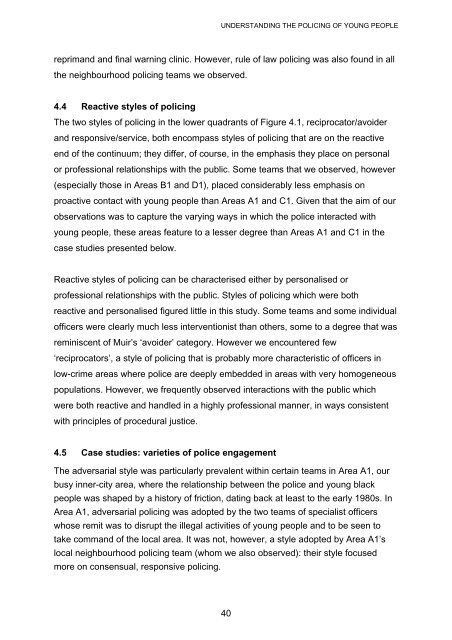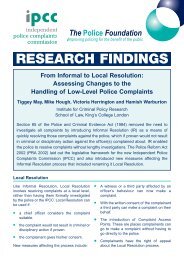Differential treatment in the youth justice system - Equality and ...
Differential treatment in the youth justice system - Equality and ...
Differential treatment in the youth justice system - Equality and ...
You also want an ePaper? Increase the reach of your titles
YUMPU automatically turns print PDFs into web optimized ePapers that Google loves.
UNDERSTANDING THE POLICING OF YOUNG PEOPLEreprim<strong>and</strong> <strong>and</strong> f<strong>in</strong>al warn<strong>in</strong>g cl<strong>in</strong>ic. However, rule of law polic<strong>in</strong>g was also found <strong>in</strong> all<strong>the</strong> neighbourhood polic<strong>in</strong>g teams we observed.4.4 Reactive styles of polic<strong>in</strong>gThe two styles of polic<strong>in</strong>g <strong>in</strong> <strong>the</strong> lower quadrants of Figure 4.1, reciprocator/avoider<strong>and</strong> responsive/service, both encompass styles of polic<strong>in</strong>g that are on <strong>the</strong> reactiveend of <strong>the</strong> cont<strong>in</strong>uum; <strong>the</strong>y differ, of course, <strong>in</strong> <strong>the</strong> emphasis <strong>the</strong>y place on personalor professional relationships with <strong>the</strong> public. Some teams that we observed, however(especially those <strong>in</strong> Areas B1 <strong>and</strong> D1), placed considerably less emphasis onproactive contact with young people than Areas A1 <strong>and</strong> C1. Given that <strong>the</strong> aim of ourobservations was to capture <strong>the</strong> vary<strong>in</strong>g ways <strong>in</strong> which <strong>the</strong> police <strong>in</strong>teracted withyoung people, <strong>the</strong>se areas feature to a lesser degree than Areas A1 <strong>and</strong> C1 <strong>in</strong> <strong>the</strong>case studies presented below.Reactive styles of polic<strong>in</strong>g can be characterised ei<strong>the</strong>r by personalised orprofessional relationships with <strong>the</strong> public. Styles of polic<strong>in</strong>g which were bothreactive <strong>and</strong> personalised figured little <strong>in</strong> this study. Some teams <strong>and</strong> some <strong>in</strong>dividualofficers were clearly much less <strong>in</strong>terventionist than o<strong>the</strong>rs, some to a degree that wasrem<strong>in</strong>iscent of Muir’s ‘avoider’ category. However we encountered few‘reciprocators’, a style of polic<strong>in</strong>g that is probably more characteristic of officers <strong>in</strong>low-crime areas where police are deeply embedded <strong>in</strong> areas with very homogeneouspopulations. However, we frequently observed <strong>in</strong>teractions with <strong>the</strong> public whichwere both reactive <strong>and</strong> h<strong>and</strong>led <strong>in</strong> a highly professional manner, <strong>in</strong> ways consistentwith pr<strong>in</strong>ciples of procedural <strong>justice</strong>.4.5 Case studies: varieties of police engagementThe adversarial style was particularly prevalent with<strong>in</strong> certa<strong>in</strong> teams <strong>in</strong> Area A1, ourbusy <strong>in</strong>ner-city area, where <strong>the</strong> relationship between <strong>the</strong> police <strong>and</strong> young blackpeople was shaped by a history of friction, dat<strong>in</strong>g back at least to <strong>the</strong> early 1980s. InArea A1, adversarial polic<strong>in</strong>g was adopted by <strong>the</strong> two teams of specialist officerswhose remit was to disrupt <strong>the</strong> illegal activities of young people <strong>and</strong> to be seen totake comm<strong>and</strong> of <strong>the</strong> local area. It was not, however, a style adopted by Area A1’slocal neighbourhood polic<strong>in</strong>g team (whom we also observed): <strong>the</strong>ir style focusedmore on consensual, responsive polic<strong>in</strong>g.40






